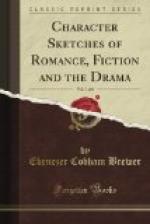Tennyson, The Princess, ii.
Artemis’ia, daughter of Hecatomnus and sister-wife of Mauso’lus. Artemisia was queen of Caria, and at the death of her fraternal husband raised a monument to his memory (called a mausole’um), which was one of the “Seven Wonders of the World.” It was built by four different architects: Scopas, Timotheus, Leochares, and Bruxis.
This made the four rare masters which
began
Fair Artemysia’s husband’s
dainty tomb
(When death took her before the work was
done,
And so bereft them of all hopes to come),
That they would yet their own work perfect
make
E’en for their workes, and their
self-glories sake.
Lord Brooke, An Inquiry upon Fame, etc. (1554-1628).
ARTEMUS WARD, travelling showman and philosopher, whose adventures and sayings as given by Charles Brown were a new departure in the history of American dialect literature (1862).
ARTFUL DODGER, the sobriquet of John Dawkins, a young thief, up to every sort of dodge, and a most marvellous adept in villainy.—Dickens, Oliver Twist (1837).
ARTHGALLO, a mythical British king, brother of Gorbonian, his predecessor on the throne, and son of Mor’vidus, the tyrant who was swallowed by a sea-monster. Arthgallo was deposed, and his brother El’idure was advanced to the throne instead.—Geoffrey, British History, iii. 17 (1142).
ARTHUR (King), parentage of. His father was Uther the pendragon, and his mother Ygerne (3 syl.), widow of Gorlois duke of Cornwall. But Ygerne had been a widow only three hours, and knew not that the duke was dead (pt. i. 2), and her marriage with the pendragon was not consummated till thirteen days afterwards. When the boy was born Merlin took him, and he was brought up as the foster-son of sir Ector (Tennyson says “sir Anton"), till Merlin thought proper to announce him as the lawful successor of Uther, and had him crowned. Uther lived two years after his marriage with Ygerne.—Sir T. Malory, History of Prince Arthur, i. 2, 6 (1470).
Wherefore Merlin took the child
And gave him to sir Anton, an old knight
And ancient friend of Uther; and his wife
Nursed the young prince, and reared him
with her own.
Tennyson, Coming of Arthur.
Coming of Arthur. Leod’ogran, king of Cam’eliard (3 syl.), appealed to Arthur to assist him in clearing his kingdom of robbers and wild beasts. This being done, Arthur sent three of his knights to Leodogran, to beg the hand of his daughter Guenever in marriage. To this Leodogran, after some little hesitation, agreed, and sir Lancelot was sent to escort the lady to Arthur’s court.
Arthur not dead. According to tradition Arthur is not dead, but rests in Glastonbury, “till he shall come again full twice as fair, to rule over his people.” (See BARBAROSSA.)
According to tradition, Arthur never died, but was converted into a raven by enchantment, and will, in the fulness of time, appear again in his original shape, to recover his throne and sceptre. For this reason there is never a raven killed in England.—Cervantes, Don Quixote, I ii. 5 (1605).




